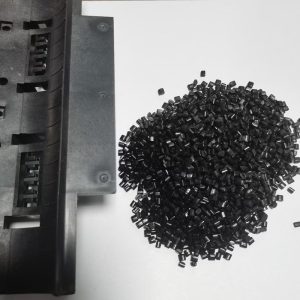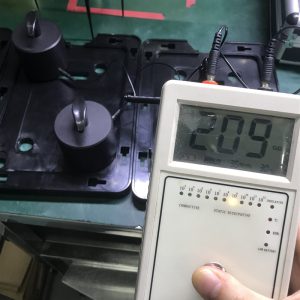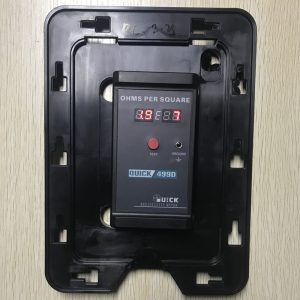Introduction to surface resistance and volume resistance
Electrical performance is one of the important requirements for electrically conductive plastics, which includes surface resistivity and volume resistivity. The surface resistivity and volume resistivity of electrically conductive plastics are two important parameters to measure their conductive properties.

1. Surface resistance
It refers to the resistance between two specific points on the surface of electrically conductive plastics. The two points are usually on the same plane of the material, and the current flows between the two points along the surface of the material. The surface resistance reflects the resistance of the surface layer of the conductive plastic to the current. Surface resistance is very important for evaluating the performance of electrically conductive plastics in applications that require surface conductivity or antistatic. For example, in the manufacture of electronic device housings, if conductive plastics are used, lower surface resistance can ensure that the housing can effectively conduct static electricity to the ground and prevent static electricity accumulation from damaging electronic components.
2. Volume resistance
It refers to the resistance encountered by the current passing through the volume of the material inside the electrically conductive plastic. It reflects the overall conductive properties of the conductive plastic, including the distribution of conductive particles inside the material, the properties of the matrix material, and the interaction between the conductive particles and the matrix. The volume resistance is a more comprehensive indicator to measure the conductive properties of conductive plastics. Compared with surface resistance, volume resistance is a better reflection of the intrinsic conductive properties of a material. Volume resistance is a critical parameter in some applications where high conductivity is required, such as when electrically conductive plastics are used as insulation for wires and cables or as electromagnetic shielding materials.
Test conditions for resistance measurement
ANSI/ESD Association recognizes the impact of test environment or conditions on test results, such as testing or manufacturing materials under high humidity and passing all specifications, but when the customer receives the material and uses it at lower humidity or temperature, the electrically conductive plastic cannot pass the specifications.
Test voltage
The test voltages generally applied are 10v and 100v. According to ESDA standards S4.1, S7.1, and S11.11, 10v can be selected for the surface of electrically conductive plastics less than 10E6; 100v can be selected for materials 10E6 or greater. If the meter cannot automatically apply the correct voltage, it will suggest that you manually change to the correct setting. Use the switch on the front of the meter to switch the voltage setting.

Temperature and humidity
Humidity and temperature can affect the resistance of the electrically conductive plastic being tested. The combination of low humidity and low temperatures will produce the highest resistance results and the slowest dissipation times. At high humidity, a thin layer of water will condense on the electrically conductive plastic being tested or absorbed. The same is true for hygroscopic additives that are added to the material to increase conductivity. At high temperatures, the mobility of free electrons increases, which also increases the conductivity of the electrically conductive plastic. This is especially true for carbon black, metal fibers, and other substances. When electrically conductive plastics are at lower temperatures, internal stresses are created, which can increase resistance due to the increased distance between the conductive additives.
Measuring surface resistivity using internal electrodes
- Before testing, make sure the surface to be tested is clean and free of any contaminants.
- Allow the meter to adjust to the environment where it will be utilized. It may take up to half an hour to acclimate to new environmental conditions.
- Place the two electrodes in contact with the electrically conductive plastic sample at two locations, ensuring good contact between the electrodes and the sample. The tester will display the surface resistivity of the material being tested.
- Adjust the switch to the desired test voltage position, 10 volts or 100 volts, depending on the target range of the material.
- Press and hold the test button, applying approximately three to five pounds of force. The display will show humidity and temperature. After approximately ten seconds, the test meter will display the surface resistivity in ohms/square. The meter will continuously update the display while the button is pressed. The last reading will be displayed for approximately twenty seconds after the button is released.

Measuring volume resistivity
Two electrodes are used in contact with the conductive metal plate and the specimen of electrically conductive plastic, one electrode acts as a current electrode, and the other acts as a voltage electrode. A current is passed through the current electrode, and the resistance is calculated using Ohm’s law by measuring the voltage at the voltage electrode.
A. Connect one end of each test lead to the meter’s receptacle. Connect the other end of the test coil wire to a 5-pound hammer.
B. Place a specimen of conductive plastic on a conductive metal plate (such as stainless steel). Place one of the 5-pound hammers on the specimen so that the specimen is sandwiched between the hammer and the metal plate.
C. Place the second 5-pound hammer on the conductive metal plate.
D. Press the “Test” button, and the value will be displayed on the LCD. Volume resistance is measured in Ohm-cm.




